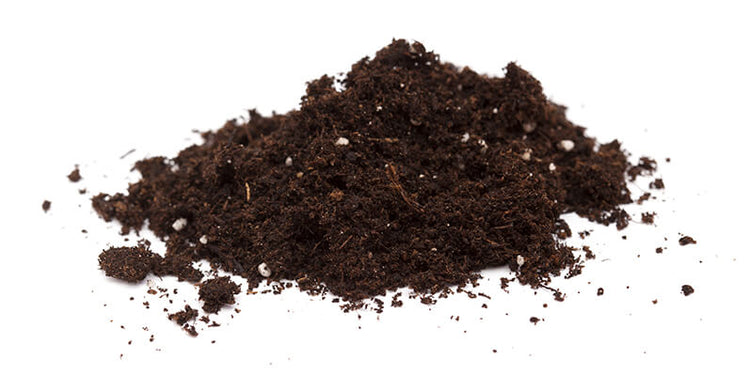Organic matter (OM) is an essential soil element needed for healthy plants. It is home to many different types of microorganisms and macroorganisms that contribute to creating a healthy environment for plants. Beneficial microorganisms are the primary vehicle for converting soil OM into nutrients and soil components. OM helps in retaining water, is a home to beneficial microbes, it raises the soil's CEC, is a food source for microorganisms and earthworms and contains all the essential plant nutrients. All nutrients that come from OM are in a form plants can use.
Where Organic Matter Comes From
Organic Matter comes mostly from plant tissue. This may consist of grass blades left on the lawn after mowing, shed roots, plant stems, fallen leaves, decomposed branches and twigs, and more.
A single blade of healthy grass will live for about 40 - 60 days before dying. This is why grass plants have to continually put out new tillers. These dead blades contribute to the soil's OM. Healthy grass will be able to out pace the shed blades so the grass doesn't thin. Not only that, but a grass plant will shed its older roots and replace them throughout the year. These shed roots also contribute to the soil OM.
Other contributors to soil organic matter are leaves from trees and shrubs, fallen twigs, insect bodies, earthworms, insect feces, and more are all contributors to your soil's OM.
Plant Nutrient Cycle
Plant tissue contains 60 - 90% water. As the tissue dries it also decomposes, primarily via soil microorganisms made up of bacteria and fungi of a group labeled, "the decomposers". They release the nutrients contained in the plant and animal tissue back into the soil to be used again. This is called "The Nutrient Cycle". What is released back into the soil consists of carbon (C), Nitrogen (N), Phosphorus (P), Potassium (K) sulphur (S), calcium (Ca) and magnesium (Mg) and more. There are a total of 16 essential nutrients plants need.
As an example, if you do not remove the grass blades when mowing, but leave them on the lawn to decompose, it puts back 1 - 2 lbs Nitrogen each year. Figuring this into your maintenance can reduce the amount of nutrients you add through fertilization.
Different Forms of Organic Matter
Soil organic matter is made up of different components in different stages of decomposition. They consist of:
- Plant Residues - mown grass blades, tree and plant leaves, shed roots, etc.
-
Microbial Biomass - The Microbial Biomass is the measure of the living component of soil organic matter. These microbes breakdown plant and animal tissues into nutrients. The process continues until it reaches its final stage of growth. (Many hands make light work, learn more on why having an abundance of beneficial microbes in the soil at critical stages throughout the growing season is like having extra hands on the farm during harvest.)
-
Detritus - Detritus is organic matter that was produced by living organisms, either while alive or dead. It includes dead and decomposing organisms such as earthworms and insects bodies, soil bacteria and fungi as well as fecal matter left behind by living organisms.
-
Humus - This is the final result of fully decomposed organic matter. It is OM that has been decomposed as far as it can go and is what gives healthy soil its dark color. It can remain in this state for centuries. However, humus adds tremendously to soil health in many ways.
Humus indirectly contributes to soil fertility by absorbing and storing soil nutrients in a plant available form. It also forms good components of soil structure and soil tilth. Humus can absorb many times its weight in water and it can trap air that helps make soil more porous. All of this contributes to a more suitable base for plant life and microorganisms.
Beneficial soil fungi have the primary role of binding soil particles together into larger aggregates that provide better air and water penetration and add a resistance to erosion and compaction
How Much OM is Needed for Turf
Healthy turf does well on 2 - 4% OM. If a soil test shows below 1.5% organic matter, consider adding amendments in the form of compost or high quality loamy soil. It may take several thin applications spaced a couple months apart to reach the desired amount . For turf, you do not need more than 6% OM. Having more than 6% can start to reverse your efforts of creating the perfect turf. For example, sod that is grown in high OM soil has difficulty rooting well in clay loam or sandy soils and the sod may be unsellable.
Look to AgriGro® for Help
AgriGro's Turf Formula® mixed with SuperCal® Calcium forms a powerful bio-enhanced calcium that increases the soil's native microorganisms by 3,400% in 24 hours and 5,000% in 72 hours.
This speeds up the breakdown from plant tissue to nutrients and helps to build soil structure. In addition, plant root mass increases in number and depth. It also helps with more efficient photosynthesis, increases fluid and nutrient uptake and improves plant health.
If you are planting seed, SeedMaxx® from AgriGro's Crops line helps with seed germination and helps seedlings to establish a more even emergence and root well. You can't go wrong with these well proven products.
Call today for a free soil analysis to determine exactly what your turf needs.
Russ James
AgriGro Turf Specialist


